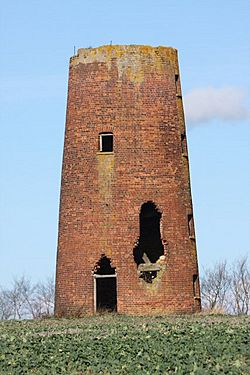Chilton Street Mill, Clare facts for kids
Quick facts for kids Chilton Street Mill, Clare |
|
|---|---|

Chilton Street Mill, February 2011
|
|
| Origin | |
| Mill name | Chilton Street Mill |
| Grid reference | TL 757 472 |
| Coordinates | 52°05′42″N 0°33′57″E / 52.095°N 0.5658°E |
| Operator(s) | Private |
| Year built | 1846 |
| Information | |
| Purpose | Corn mill |
| Type | Tower mill |
| Storeys | Five storeys |
| No. of sails | Four Sails |
| Type of sails | Patent sails |
| Winding | Fantail |
| No. of pairs of millstones | Two pairs |
The Chilton Street Mill is an old tower mill located in Clare, a town in Suffolk, England. Today, it stands empty and unused. A tower mill is a type of windmill where the main building is a tall, round tower.
Contents
History of Chilton Street Mill
When the Mill Was Built
Chilton Street Mill was built in 1846. Windmills like this one were very important long ago. They used the power of the wind to grind grain into flour. This flour was then used to make bread and other foods.
Why the Mill Stopped Working
The mill stopped working sometime before the First World War. This happened because its large sails were blown off. Without its sails, the mill could no longer catch the wind to power its machinery.
What Happened After It Stopped
In the late 1920s or early 1930s, the mill was emptied. All of its important working parts, like the gears and grinding stones, were taken out. Now, the mill is just an empty shell. This means only the main tower building remains, without any of its original machinery inside.
How the Mill Was Designed
Understanding the Mill's Structure
Chilton Street Mill is a five-storey tower mill. This means it has five levels inside its tall, round building. At the very top, it had a special domed cap. This cap could turn to face the wind.
How the Mill Caught the Wind
The cap was turned by something called a fantail. A fantail is a small windmill at the back of the cap. It automatically turned the main cap and sails into the wind. This made sure the mill always caught the most wind power.
The Sails and Grinding Stones
The mill had four large Patent sails. These sails were special because they could be adjusted easily. They were connected to machinery inside the mill. These sails powered two pairs of millstones. Millstones are large, heavy stones that spin to grind grain into flour.

